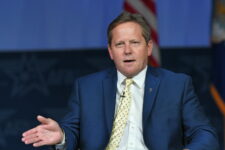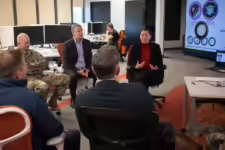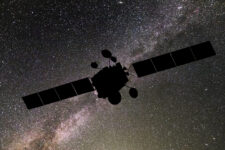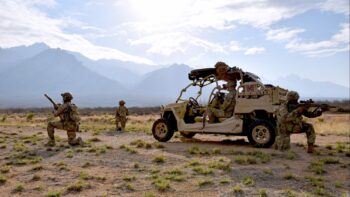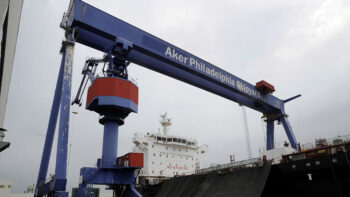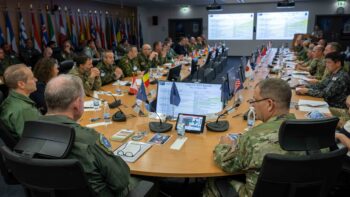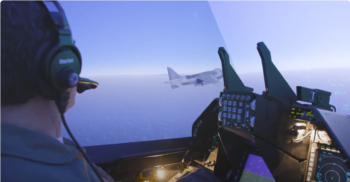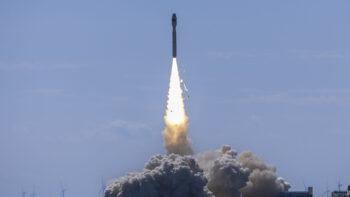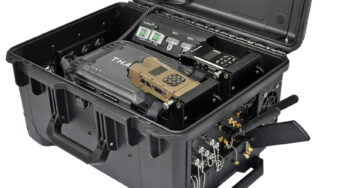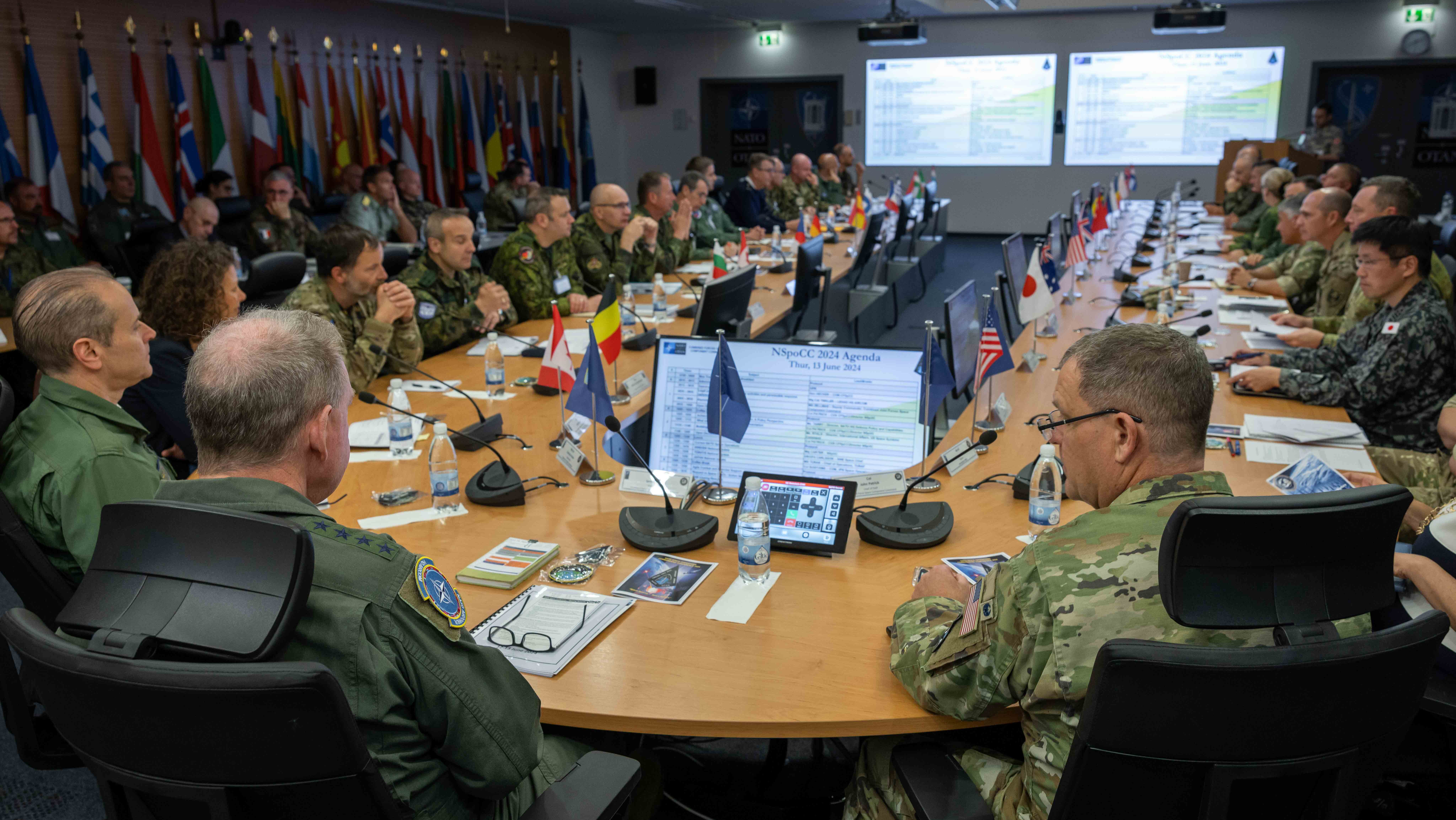
NATO Allies from 23 Nations and two Partner Nations, Australia and Japan, participate in the second ever NATO Space Operations Commanders’ Conference at Allied Air Command, June 12-13, 2024. Participants discussed space capability and capacity through collaboration and cooperation with a focus on Space Security and Space Warfare. (NATO AIRCOM photo by OR-9 Arnaud Chamberlin)
WASHINGTON — NATO’s planning directorate is working to identify what space capabilities each allied nation can bring to the collective fight with the goal of assigning national contributions of kit and people power, according to a senior NATO officer.
“There’s an effort right now from the headquarters to survey all 32 nations to tell us exactly what space capability you have. That way, we can assign targets to you, and we can direct you to provide that capability to NATO,” said Maj. Gen. Devin Pepper, deputy chief of staff for strategic plans and policy at NATO’s Allied Command Transformation (ACT).
ACT, based in Norfolk, Va., is the only NATO headquarters based in the United States. It serves as NATO’s “Strategic Warfare Development Command” responsible for the development of military structures, forces, capabilities and doctrine, according to a NATO fact sheet. NATO’s other strategic command, Allied Command Operations (ACO) headquartered in Mons, Belgium, is the alliance’s warfighting command.
Pepper, who is the first US Space Force general officer to be assigned to NATO headquarters, told the Mitchell Institute today that, at the moment, the US provides the bulk of space capabilities “that NATO can leverage today in an exercise or in a potential conflict.” This includes, he said, everything from GPS to ballistic missile warning to satellite communications (SATCOM) to intelligence, surveillance and reconnaissance (ISR).
“But there’s other nations out there that that have space capabilities that can contribute as well, in addition to commercial capabilities,” he said.
Pepper explained that while NATO in 2019 agreed to its first space policy, and in June 2024 created a Space Branch under ACT, the alliance up to now has only laid out what space missions are important and the general types of capabilities it needs to face up to threats from Russia and China.
“My director is responsible for what’s called the NATO Defense Planning Process [NDPP]. That is a … four-year process that we go through to look at what capability targets that we assign to the nation,” he said. First, ACT takes stock of national capabilities and assets — “such as carriers or fighters or medical groups or battalions.” Based on that assessment, the command determines “these are the things that are required in order to prosecute the deterrence and defense plan from ACO and from [the Supreme Allied Commander Europe]” from each member state.
“Right now in the NDPP, we only have qualitative requirements that we assign it to the nation,” Pepper said. “So: ‘Please deliver us [electromagnetic spectrum] capability or SATCOM or ISR.’ We have not gotten to the point where we have assigned quantitative targets to the nations. So, in other words, until we know exactly what a nation has that they can offer, we can’t task them to provide it yet. We’re working through that right now.”
ACT is “at the beginning” of the process, Pepper noted.
“Where do we go from here? What space capabilities to each of the nations have that NATO can leverage?” he asked. “How do we leverage all of the nations’ capability, and then where do we direct them to provide investments to?”
To help the allies work out exactly what will be required by the collective force, Pepper said ACT is creating a tabletop exercise going through “thought scenarios” and “vignettes” on “where space is relevant and appropriate” to allied operations for NATO’s Military Committee.
“I’ll give you an example. In the NDPP, we have asked nations to provide offensive space capability,” he said. “But in order to leverage that capability, you have to get consensus from all 32 nations. Well, we have a war game on how you get to consensus.”
The Military Committee, which meets three times a year at its top level of allied defense chiefs, “is responsible for translating political decision and guidance into military direction, and for recommending measures considered necessary for the defence of the NATO area and the implementation of decisions regarding military operations,” according to a NATO fact sheet.
To attack enemy space capabilities, Army eyes doubling expert cadre
“We’re very much complimentary to the Space Force and to the other services, but we truly do see space as that critical component to set the theater well in advance of phase one operations,” Col. Donald Brooks, commandant of the Space and Missile Defense Center of Excellence, told Breaking Defense. “When the first round is shot, the missile is shot, space needs to be there months, if not years, in advance to help set those conditions.”
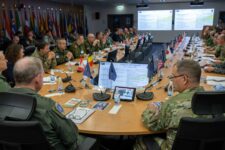


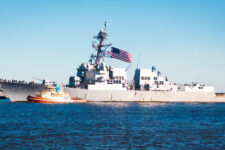
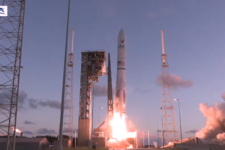
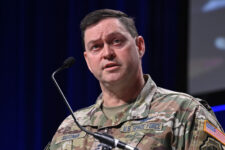
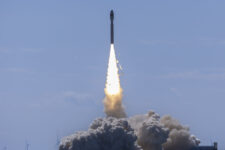
![Apex Anduril Image[82]](https://breakingdefense.com/wp-content/uploads/sites/3/2024/10/Apex-Anduril-Image82-1-e1727799837617-225x150.png)


